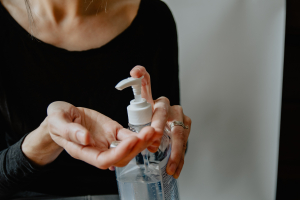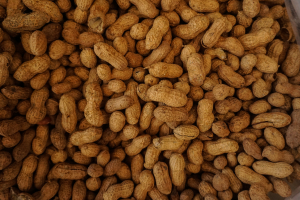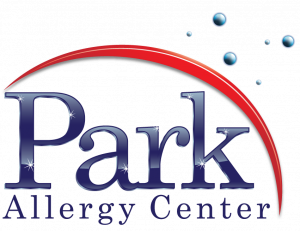Please check back with us for the latest news, announcements, and updates at Park Allergy Center! We regularly update our site with the latest allergy news and tips.

Assume you have the virus and act accordingly. Most people act defensively, trying to not to get infected. On the other hand, acting as if you already have the virus and doing your best to prevent infecting others is another step up in prevention. The number of times you clean you hands will go up significantly.
Do not let your respiratory droplets land on someone else. Obvious sources of respiratory droplets are sneezing and coughing, but one important source that can’t be overlooked is talking. All of us spit a little, some more than others, while we talk. Make sure you are at least 3 feet away when talking to someone, even loved ones (yes 6 feet is even better).
Keep your hands clean, as they are a primary source of spreading respiratory droplets. Lick your finger? Clean your hands. Touch your face? Clean your hands. Touch your hair? Clean your hands. Eat something? Clean your hands. Reach for another slice of pizza? Clean your hands before grabbing another slice. Drink something? Small droplets of saliva can land on you hands, contaminating them. Clean your hands.
Further, be aggressive with your defenses. Open or close a public door? Clean your hands. Pump gas into your car? Clean your hands. Light switch. Clean your hands. Keyboard/mouse? Clean your hands. Pencil? Clean your hands. Get the picture?
On 1/31/20, Palforzia became the first FDA approved treatment for peanut allergy.
Here are my initial thoughts about this new product.
First of all, Palforzia isn’t really a drug at all. Palforzia is simply peanut powder placed in capsules at specific doses ranging from 0.5mg to 300mg. The capsule is not consumed, rather the powder is mixed with another food like apple sauce, then consumed.
The first day is done at the doctor’s office, consisting of 5 separate doses starting at 0.5mg and ending at 6mg.
The patient then goes home and consumes 3mg once a day for 2 weeks.

Every 2 weeks, the dose is increased with the first higher dose given at the doctor’s office.
If all goes well the build up schedule is completed in 22 weeks and the patient then takes a daily maintenance dose of 300mg. If you miss 3 days or more, you need to reduce the dose or perhaps even start all over.
Just in case you’re wondering, the average peanut contains about 200mg of peanut protein. So the maintenance dose of 300mg is equal to about 1.5 peanuts.
Palforzia is not a cure for peanut allergy. It decreases the chance of having an allergic reaction to a small ingestion of peanut (1-2 peanuts).
In the studies for Palforzia, the rate of anaphylaxis during the build up phase was 9.4%.
The rate of anaphylaxis during the maintenance phase was 8.7%
Other reactions like abdominal pain were as high as 67% in the build up phase, 30% in the maintenance phase.
And remember, the vast majority of the doses are given at home.
So, as you can see, Palforzia is not the “cure” we have been hoping for.
If offers some protection against accidental reactions – but acquiring that protection comes with risk.
Further, in similar desensitization studies previously done using peanut powder, the dropout rate in patients who successfully reached maintenance dose was 50% after the 1st year. It turns out, it’s not easy to consume a maintenance dose of peanuts every single day.
In summary, I do not think the risk is worth the reward for most people when it comes to Palforzia.
The best treatment advice for most peanut allergic patients remains strict avoidance and to have injectable epinephrine readily available in case of accidental ingestion and reaction.
However, for parents and patients who want to take the risk, Palforzia offers a convenient way to obtain precise doses of peanut protein to attempt desensitization.
Michael Park, MD
With the arrival of winter, there are several things to consider if you have allergies. First, if you haven’t done it already, now is a good time to change the filter on your furnace. Dust has likely accumulated in your furnace for 6 months and old filters, burdened with a large dust load, do not filter as well as new, clean ones.
Outdoor allergies resolve in the winter but indoor allergies usually worsen. The most common indoor allergies are cat, dog and other furry animals. Dust mite allergy also tends to worsen in the winter.

Humidity is something that tends to confuse most people. I often see patients who use a steamer or humidifier thinking it will decrease their “allergies.” But if cat and dog are the main indoor allergens, how will a humidifier improve pet allergies? The answer is they won’t. Do they help dust mite allergy? No, just the opposite. One of the ways to control dust mite population is to keep the humidity low, not high. Two things that are helped by using a humidifier in the winter are dry nasal passages and dry skin. Many patients with allergies also have eczema. Dry skin usually results in a flare of eczema. So, using a humidifier in the winter can help eczema. It can also help a dry nose. Using a water based lubricant for the nasal passages is another way to improve dry nostrils in the winter. A good rule of thumb is to keep the humidity below 50%, whether it is summer or winter.
During the holiday season, many people get live Christmas trees. Unfortunately, these trees tend to have a lot of mold on them. Since Christmas trees do not pollinate in the winter, and definitely do not pollinate in your living room, the increase in symptoms that occur once the Christmas tree is put up and decorated is usually caused by the mold. If you have significant mold allergies, it would be best to use an artificial Christmas tree.
Michael Park, MD

